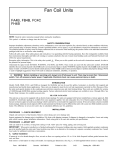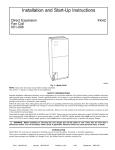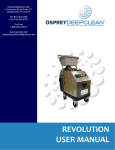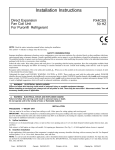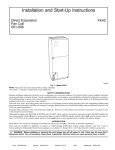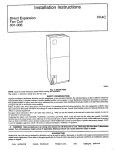Download BDP FB4A Instruction manual
Transcript
Direct Expansion Fan Coil Units Fan Unit FA4A, FB4A, FC4B FH4A NOTE: Read the entire instruction manual before starting the installation. This symbol → indicates a change since the last issue. SAFETY CONSIDERATIONS Improper installation, adjustment, alteration, service, maintenance, or use can cause explosion, fire, electrical shock, or other conditions which may cause personal injury or property damage. Consult a qualified installer, service agency, or your distributor or branch for information or assistance. The qualified installer or agency must use factory-authorized kits or accessories when modifying this product. Refer to the individual instructions packaged with kits or accessories when installing. Follow all safety codes. Wear safety glasses and work gloves. Use quenching cloth for brazing operations. Have fire extinguisher available. Read these instructions thoroughly and follow all warnings or cautions attached to the unit. Consult local building codes and National Electrical Code (NEC) for special requirements. . When you see this symbol on the unit and in instructions manuals, be alert to Recognize safety information. This is the safety-alert symbol the potential for personal injury. Understand the signal words DANGER, WARNING, CAUTION, and NOTE. These words are used with the safety-alert symbol. DANGER identifies the most serious hazards which will result in severe personal injury or death. WARNING signifies hazards which could result in personal injury or death. CAUTION is used to identify unsafe practices which would result in minor personal injury or product and property damage. NOTE is used to highlight suggestions which will result in enhanced installation, reliability, or operation. WARNING: Before installing or servicing unit, always turn off all power to unit. There may be more than 1 disconnect switch. Turn off accessory heater power if applicable. Electrical shock can cause personal injury or death. INTRODUCTION Models FA4A, FB4A, FC4B, and FH4A are designed for flexibility and can be used for upflow, horizontal, or downflow (kit required and manufactured and mobile home) applications. These units are available for systems of 24,000 through 60,000 Btuh nominal cooling capacity. Factory authorized electric heater packages are available in sizes 3 through 30kw. See Product Data Literature for available accessory kits. HEATER PACKAGES This unit may or may not be equipped with an electric heater package. For units not equipped with factory installed heat, a factory approved, field installed UL listed heater package is available from your equipment supplier. See unit rating plate for a list of factory approved heaters. Heaters that are not factory approved could cause damage which would not be covered under the equipment warranty. If fan coil contains a factory installed heater package, minimum circuit ampacity (MCA) and maximum fuse/breaker may be different than units with a same size field installed accessory heater. The difference is not an error and is due to calculation difference per UL guidelines. INSTALLATION PROCEDURE 1—MOUNT UNIT Unit can stand or lie on floor, or hang from ceiling or wall. Allow space for wiring, piping, and servicing unit. IMPORTANT: When unit is installed over a finished ceiling and/or living area, building codes may require a field-supplied secondary condensate pan to be installed under the entire unit. Some localities may allow as an alternative, the running of a separate, secondary condensate line. Consult local codes for additional restrictions or precautions. A. Upflow Installation If return air is to be ducted through a floor, set unit on floor over opening and use 1/8- to 1/4-in. thick fireproof resilient gasket between duct, unit, and floor. Side return is a field option on slope coil models. Cut opening per dimensions. (See Fig. 1.) A field-supplied bottom closure is required. B. Downflow Installation In this application, field conversion of the evaporator coil is required using accessory downflow kit along with an accessory base kit. See installation instructions packaged with accessory kit. See Product Data for kit part numbers. C. Horizontal Installation Units must not be installed with access panels facing up or down. The FH4A003 and 004 size units equipped with accessory cooling coils are not approved for horizontal applications. All other units are factory built for horizontal left installation. (See Fig. 2 and 6.) When suspending unit from ceiling, dimples in casing indicate suitable location of screws for mounting metal support straps. (See Fig. 2.) Form: IM-FA4A-11 Cancels: IM-FA4A-10 Printed in U.S.A. 3-02 Catalog No. 63FA-4A6 FIELD SUPPLIED SUPPLY DUCT POWER ENTRY OPTIONS LOW VOLT ENTRY OPTIONS 018-060 21-IN. FRONT SERVICE 070 24-IN. CLEARANCE UNIT 018/024 030/036 042 A COIL UNITS UPFLOW/DOWNFLOW SECONDARY DRAIN A 12 In. 17 In. 19 In. 1 1⁄2″ UPFLOW/DOWNFLOW PRIMARY DRAIN 19″ A 2 1⁄2″ FIELD MODIFIED SIDE RETURN LOCATION FOR SLOPE COIL UNITS ONLY UPFLOW/DOWNFLOW SECONDARY DRAIN UPFLOW/DOWNFLOW PRIMARY DRAIN FIELD SUPPLIED RETURN PLENUM A00069 Fig. 1—Slope Coil Unit in Upflow Application CAUTION: For optimum condensate drainage performance in horizontal installations, unit should be leveled along its length and width. NOTE: Modular units can be disassembled and components moved separately to installation area for reassembly. This process accommodates small scuttle holes and limiting entrances to installation sites. (See Fig. 3.) HORIZONTAL RIGHT CONVERSION OF UNITS WITH SLOPE COILS 1. Remove blower and coil access panel and fitting panel. (See Fig. 4.) 2. Remove coil mounting screw securing coil assembly to right side casing flange. 3. Remove coil assembly. 4. Lay fan coil unit on its right side and reinstall coil assembly with condensate pan down. (See Fig. 4.) 5. Attach coil to casing flange using coil mounting screw previously removed. 6. Align holes with tubing connections and condensate pan connections, and reinstall access panels and fitting panel. Make sure liquid and suction tube grommets are in place to prevent air leaks and cabinet sweating. Install after brazing. HORIZONTAL RIGHT CONVERSION OF UNITS WITH A-COILS 1. Remove blower and coil access panels. (See Fig. 5.) 2. Remove metal clip securing fitting panel to condensate pan. Remove fitting panel. 3. Remove 2 snap-in clips securing A-coil in unit. 4. Slide coil and pan assembly out of unit. 5. Remove horizontal drain pan support bracket from coil support rail on left side of unit and reinstall on coil support rail on right side of unit. 6. Convert air-seal assembly for horizontal right. a. Remove air-seal assembly from coil by removing 4 screws. (See Fig. 5.) b. Remove air splitter (B) from coil seal assembly by removing 3 screws. (See Fig. 5—factory shipped inset.) c. Remove filter plate (A) and install air splitter (B) in place of filter plate. d. Install filter plate (A) as shown in horizontal right application. e. Remove condensate troughs (C) and install on opposite tube sheets. —2— A-COIL HORIZONTAL LEFT SECONDARY DRAIN FIELD SUPPLIED HANGING STRAPS PRIMARY DRAIN 018-060 21-IN. 070 24-IN. FRONT SERVICE CLEARANCE (FULL FACE OF UNIT) UNIT LOW VOLT ENTRY OPTIONS 1 3/4 IN. FILTER ACCESS CLEARANCE PRIMARY DRAIN SECONDARY DRAIN POWER ENTRY OPTIONS A00070 Fig. 2—Slope Coil Unit in Horizontal Left Application f. Install hose onto plastic spout. 7. Install horizontal pan on right side of coil assembly. 8. Slide coil assembly into casing. Be sure coil bracket on each corner of vertical pan engages coil support rails. 9. Reinstall 2 snap-in clips to correctly position and secure coil assembly in unit. Be sure clip with large offsets is used on right side of unit to secure horizontal pan. 10. Remove 2 oval coil access panel plugs and reinstall into holes on left side of coil access panel and fitting panel. 11. Remove insulation knockouts on right side of coil access panel 12. Reinstall access fitting panels, aligning holes with tubing connections and condensate pan connections. Be sure to reinstall metal clip between fitting panel and vertical condensate pan. Make sure liquid and suction tube grommets are in place to prevent air leaks and cabinet sweating. → D. Manufactured and Mobile Home Housing Applications 1. Fan coil unit must be secured to the structure using field-supplied hardware. 2. Allow a minimum of 24” clearance from access panels. 3. Recommended method of securing for typical applications a. If fan coil is away from wall, attach pipe strap to top of fan coil using No. 10 self tapping screws. Angle strap down and away from back of fan coil, remove all slack, and fasten to wall stud of structure using 5/16-in. lag screws. Typical both sides of fan coil. b. If fan coil is against wall, secure fan coil to wall stud using 1/8-in. thick right-angle brackets. Attach brackets to fan coil using No. 10 self tapping screws and to wall stud using 5/16-in. lag screws. (See Fig. 7.) PROCEDURE 2—AIR DUCTS Connect supply-air duct over the outside of 3/4-in. flanges provided on supply-air opening. Secure duct to flange, using proper fasteners for type of duct used, and seal duct-to-unit joint. If return-air flanges are required, install factory-authorized accessory kit. —3— BLOWER BOX 2 SCREWS 2 SCREWS REAR CORNER BRACKET 2 SCREWS COIL BOX A95293 Fig. 3—Removal of Brackets on Modular Units use flexible connectors between ductwork and unit to prevent transmission of vibration. When electric heater is installed, use heat-resistant material for flexible connector between ductwork and unit at discharge connection. Ductwork passing through unconditioned space must be insulated and covered with vapor barrier. Units equipped with 20-30kw electric heaters require a 1-in. clearance to combustible materials for the first 36 in. of supply duct. Ductwork Acoustical Treatment Metal duct systems that do not have a 90° elbow and 10 ft of main duct to first branch takeoff may require internal acoustical insulation lining. As an alternative, fibrous ductwork may be used if constructed and installed in accordance with the latest edition of SMACNA construction standard on fibrous glass ducts. Both acoustical lining and fibrous ductwork shall comply with National Fire Protection Association as tested by UL Standard 181 for Class 1 air ducts. PROCEDURE 3—ELECTRICAL CONNECTIONS All products from the factory utilize a printed-circuit board (PCB) which has a low voltage circuit protective fuse (5 amp), fan motor speed tap selection terminal (SPT), and time delay relay (TDR) jumper. To disable the TDR feature, sever the jumper wire JW1. (See Fig. 8.) When a factory-approved accessory control package has been installed, check all factory wiring per unit wiring diagram and inspect factory wiring connections to be sure none were loosened in transit or installation. If a different control package is required, see unit rating plate. CAUTION: If a disconnect switch is to be mounted on unit, select a location where drill or fastener will not contact electrical or refrigerant components. Before proceeding with electrical connections, make certain that supply voltage, frequency, phase, and ampacity are as specified on the unit rating plate. See unit wiring label for proper field high- and low-voltage wiring. Make all electrical connections in accordance with the NEC and any local codes or ordinances that may apply. Use copper wire only. The unit must have a separate branch electric circuit with a field-supplied disconnect switch located within sight from and readily accessible from the unit. —4— COIL MOUNTING SCREW BLOWER ASSEMBLY COIL SUPPORT RAIL SLOPE COIL SKI DRAINPAN REFRIGERANT CONNECTIONS PRIMARY DRAIN OVERFLOW HOLE SECONDARY DRAIN A02002 → Fig. 4—Conversion for Horizontal Right Applications Using a Slope Coil A REFRIGERANT CONNECTIONS AIR SEAL ASSEMBLY HORIZONTAL RIGHT APPLICATION COIL SUPPORT RAIL B C COIL BRACKET DRAIN PAN SUPPORT BRACKET COIL SUPPORT RAIL COIL BRACKET HORIZONTAL DRAIN PAN PRIMARY DRAIN HORIZONTAL RIGHT SECONDARY DRAIN HORIZONTAL RIGHT A00071 Fig. 5—Conversion for Horizontal Right Applications Using A-Coil —5— A COIL BRACKET FACTORY SHIPPED HORIZONTAL LEFT APPLICATION COIL SUPPORT RAIL B C DRAIN PAN SUPPORT BRACKET COIL BRACKET HORIZONTAL DRAIN PAN PRIMARY DRAIN HORIZONTAL LEFT AIR SEAL ASSEMBLY SECONDARY DRAIN HORIZONTAL LEFT REFRIGERANT CONNECTIONS A00072 Fig. 6—A-Coil in Horizontal Left Application (Factory Ready) 4” MAX SECURE FAN COIL TO STRUCTURE UNIT AWAY FROM WALL PIPE STRAP (TYPICAL BOTH SIDES) OR UNIT AGAINST WALL 1/8-IN. THICK ANGLE MOUNTING BRACKET (TYPICAL BOTH SIDES) DOWN FLOW BASE KIT (KFACB) SECURE UNIT TO FLOOR ANGLE BRACKET OR PIPE STRAP 4” MAX A02003 → Fig. 7—A-Coil —6— C G K1 R5 R4 Q1 NO FAN RELAY ® HSCI NC SPT CPC-E 94V-0 D2 C1 F1 ® C2 R C5 R8 JW1 C4 C6 R11 Z1 R1 5 AMP T G R2 R3 C3 R6 R U1 R7 C T R10 R9 C7 1005-83-161A CESO130003-01 1005-161 C8 D1 LR40061 A95553 Fig. 8—Fan Coil Printed-Circuit Board On units with a factory installed disconnect with pull-out removed, service and maintenance can be safely performed on only the load side of the control package. WARNING: Field wires on the line side of the disconnect found in the fan coil unit remain live, even when the pull-out is removed. Service and maintenance to incoming wiring can not be performed until the main disconnect switch (remote to the unit) is turned off. Failure to do so will result in electrical shock causing personal injury or death. A. Line Voltage Connections FA4A units installed without electric heat require the use of a factory-authorized Power Plug Kit (KFAPP0125PLG). This kit provides the electrical connections necessary to supply the FA4A unit with 230-v power when electric heat is not present. This kit is required only on those FA4A applications which do not use electric heat. For units without electric heat: 1. Connect 208/230v power leads from field disconnect to yellow and black stripped leads. 2. Connect ground wire to unit ground lug. 3. If unit contains an electric heater, remove and discard power plug (if equipped) from fan coil and connect male plug from heater to female plug from unit wiring harness. (See Electric Heater Installation Instructions.) NOTE: Units installed without electric heat should have a field-supplied sheet metal block-off plate covering the heater opening. This will reduce air leakage and formation of exterior condensation. B. 24-v Control System CONNECTION TO UNIT Wire low voltage in accordance with wiring label on the blower. (See Fig. 9, 10, 11, 12, and 13.) Use no. 18 AWG color-coded, insulated (35°C minimum) wire to make the low-voltage connections between the thermostat, the unit, and the outdoor equipment. If the thermostat is located more than 100 ft from the unit (as measured along the low-voltage wire), use No. 16 AWG color-coded, insulated (35°C minimum) wire. All wiring must be NEC Class 1 and must be separated from incoming power leads. Refer to outdoor unit wiring instructions for any additional wiring procedure recommendations. TRANSFORMER INFORMATION Transformer is factory-wired for 230v operation. For 208v applications, disconnect the black wire from the 230v terminal on transformer and connect it to the 208v terminal. (See Fig. 14.) HEATER STAGING CAUTION: If W2, W3, and E on any 3 stage heater (18, 20, 24, or 30kw), are individually connected as with outdoor thermostats or any other situation, emergency heat relay must be used. This relay is in kit Part No. KHAOT0201SEC and is normally used with kit Part No. KHAOT0301FST for 2 outdoor thermostat system. The controls are factory circuited for single-stage operation. For 2-stage operation, use outdoor thermostat kit Part No. KHAOT0301FST, and for 3-stage use both kits Part No. KHAOT0201SEC and KHAOT0301FST. When 2 stages are desired, cut W3 at the W2 wire nut, strip and reconnect per the thermostat kit instruction. (See Fig. 12.) When 3 stages are desired, cut the W2 wire nut off and discard. Strip W2, W3, and E and reconnect per thermostat kit instructions. (See Fig. 13.) —7— FAN COIL (CONTROL) THERMOSTAT RED R GRY G W R G WHT WHT BLU VIO BRN W2 W3 E C AIR COND. C Y Y A94058 Fig. 9—Wiring Layout Air Conditioning Unit (Cooling Only) FAN COIL (CONTROL) THERMOSTAT RED R G W R GRY G WHT WHT BLU VIO BRN W2 W3 E C AIR COND. C Y Y A94059 Fig. 10—Wiring Layout Air Conditioning Unit (Cooling and 1-Stage Heat) NOTE: When 3 stages are used or anytime the E terminal is not tied to W2, the emergency heat relay, part of outdoor kit Part No. KHAOT0201SEC must be used. C. Ground Connections WARNING: According to NEC, ANSI/NFPA 70, and local codes, the cabinet must have an uninterrupted or unbroken ground to minimize personal injury if an electrical fault should occur. The ground may consist of electrical wire or metal conduit when installed in accordance with existing electrical codes. If conduit connection uses reducing washers, a separate ground wire must be used. Failure to follow this warning could result in electric shock, fire, or death. NOTE: Use UL-listed conduit and conduit connector for connecting supply wire(s) to unit to obtain proper grounding. Grounding may also be accomplished by using grounding lugs provided in control box. D. Minimum CFM and Motor Speed Selection Units with or without electric heaters require a minimum CFM. Refer to the unit wiring label to ensure that the fan speed selected is not lower than the minimum fan speed indicated. Fan speed selection is done at the fan relay printed-circuit board. To change motor speeds, disconnect fan lead used on relay terminal (SPT) and replace with motor speed tap desired. (See Fig. 15.) Save insulating cap and place on motor lead removed from relay. NOTE: In low static applications, lower motor speed tap should be used to reduce possibility of water being blown off coil. All units have 3 motor speed taps. Low speed (red) is designed for mismatch outdoor unit applications. Medium speed (blue) is designed for straight matched operations. High speed (black) is used with high external static duct systems of straight matched systems. —8— THERMOSTAT R G C W2 E FAN COIL (CONTROL) RED GRY BRN R HEAT PUMP (CONTROL) R G C C WHT W 2 BLU W3 VIO E L W2 O O Y Y A94060 Fig. 11—Wiring Layout Heat Pump Unit (Cooling and 2-Stage Heat with No Outdoor Thermostat) THERMOSTAT FAN COIL (CONTROL) R RED G GRY G C W2 E BRN R R C C WHT W 2 VIO E BLU W3 HEAT PUMP (CONTROL) W2 ODTS L O O Y Y A94061 Fig. 12—Wiring Layout Heat Pump Unit (Cooling and 2-Stage Heat with 1 Outdoor Thermostat) PROCEDURE 4—REFRIGERANT TUBING Use accessory tubing package or field-supplied tubing of refrigerant grade. Suction tube must be insulated. Do not use damaged, dirty, or contaminated tubing because it may plug refrigerant flow-control device. ALWAYS evacuate the coil and field-supplied tubing to 500 microns before opening outdoor unit service valves. CAUTION: Braze with Sil-Fos or Phos-copper on copper to copper joints and wrap a wet cloth around rear of fitting to prevent damage to TXV. PROCEDURE 5—REFRIGERANT FLOW-CONTROL DEVICE CAUTION: If using a TXV (FC4B factory installed) in conjunction with a single-phase reciprocating compressor, a compressor start capacitor and relay are required. Consult outdoor unit pre-sale literature for start assist kit part no. Replace piston if required. Check piston size shown on indoor unit rating plate to see if it matches required piston shown on outdoor unit rating plate. If it does not match, replace indoor piston with piston shipped with outdoor unit. The piston shipped with outdoor unit is correct for any approved indoor coil combination. (See Fig. 16.) When changing piston, use a back-up wrench. Hand tighten hex nut, then tighten with wrench 1/2 turn. Do not exceed 30 ft-lbs. —9— FAN COIL (CONTROL) THERMOSTAT R RED R G GRY G C BRN C W2 WHT W 2 HEAT PUMP (CONTROL) R C W2 BLU ODTS1 W3 VIO E ODTS2 L E O O Y Y C 1 4 7 C 9 6 3 EMERGENCY HEAT RELAY A94062 Fig. 13—Wiring Layout Heat Pump Unit (Cooling and 2-Stage heat with 2 Outdoor Thermostats) SECONDARY YEL BLK 230 208 C BRN RED PRIMARY A94067 PROCEDURE 6—CONDENSATE DRAINS Fig. 14—Transformer Connections Units are equipped with primary and secondary 3/4-in. FPT drain connections. For proper condensate line installations see Fig. 1, 2, 4, 5, and 6. To prevent property damage and achieve optimum drainage performance, BOTH primary and secondary drain lines should be installed and include properly-sized condensate traps. (See Fig. 17.) Factory-approved condensate traps are available (Kit No. KFAET0125ETK). Be sure to install plastic push-in plugs in unused condensate drain fittings. It is recommended that PVC fittings be used on the plastic condensate pan. Finger-tighten plus 1-1/2 turns. Do not over-tighten. Use pipe dope. CAUTION: Shallow, running traps are inadequate and DO NOT allow proper condensate drainage. (See Fig. 18.) NOTE: When connecting condensate drain lines, avoid blocking filter access panel, thus preventing filter removal. After connection, prime both primary and secondary condensate traps. NOTE: If unit is located in or above a living space where damage may result from condensate overflow, a field-supplied, external condensate pan should be installed underneath the entire unit, and a secondary condensate line (with appropriate trap) should be run from the unit into the pan. Any condensate in this external condensate pan should be drained to a noticeable place. As an alternative to using an external condensate pan, some localities may allow the use of a separate 3/4-in. condensate line (with appropriate trap) to a place where the condensate will be noticeable. The owner of the structure must be informed that when condensate flows from the secondary drain or external condensate pan, the unit requires servicing or water damage will occur. —10— PCB FAN RELAY SINGLE SPADE INSULATING CAP (2) MOTOR SPEED TAP LEADS SPEED TAP TERMINAL WRAPPER COMMON YELLOW FAN DECK A97529 Fig. 15—Fan Coil Relay and Speed Tap Terminal BRASS HEX NUT TEFLON SEAL PISTON PISTON RETAINER DISTRIBUTOR BRASS HEX BODY STRAINER A94415 Fig. 16—Refrigerant Flow-Control Device (FC4B has TXV and Strainer) —11— UNIT 2″ ΜΙΝ 2″ ΜΙΝ A02006 → Fig. 17—Recommended Condensate Trap DO NOT USE SHALLOW RUNNING TRAPS! A95320 Fig. 18—Insufficient Condensate Trap Install traps in the condensate lines as close to the coil as possible. (See Fig. 19.) Make sure that the outlet of each trap is below it connection to the condensate pan to prevent condensate from overflowing the drain pan. Prime all traps, test for leaks, and insulate traps if located above a living area. Condensate drain lines should be pitched downward at a minimum slop of 1 in. for every 10 ft of length. Consult local codes for additional restrictions or precautions. FILTER ACCESS PANEL SECONDARY DRAIN REQUIRED (USE FACTORY KIT OR FIELD-SUPPLIED TRAP) PRIMARY TRAP REQUIRED (USE FACTORY KIT OR FIELD-SUPPLIED TRAP OF SUFFICIENT DEPTH. STANDARD PRIMARY TRAPS ARE NOT SUFFICIENT. SEE FIGURE OF RECOMMENEDED CONDENSATE TRAP) A02004 → Fig. 19—Condensate Drain —12— CES0130003-01 CONTROL BOARD FAN RELAY R G T C 230VAC NO NC COM WIRE NUT SPT NO NC 208/230VAC COM 24VAC COM COM 208/ 230 CONVERSION KIT TRANSFORMER TO BLOWER MOTOR TO EAC FROM MOLEX PLUG AND TRANSFORMER (IN UNIT) A98626 Fig. 20—Wiring Layout of Electronic Air Cleaner to Fan Coil PROCEDURE 7—ACCESSORIES A. Electronic Air Cleaner The Electronic Air Cleaner may be connected to fan coil as shown in Fig. 20. This method requires a field supplied transformer. See Electronic Air Cleaner literature for kit requirements. B. Humidifier Connect humidifier and humidistat to fan coil unit as shown in Fig. 21 and Fig. 22. The cooling lockout relay is optional (See Fig. 23.) PROCEDURE 8—SEQUENCE OF OPERATION A. Continuous Fan Thermostat closes R to G. G energizes fan relay on PCB which completes circuit to indoor blower motor. When G is de-energized, there is a 90 sec delay before relay opens. B. Cooling Mode Thermostat energizes R to G, R to Y, and R to O (heat pump only). G energizes fan relay on PCB which completes circuit to indoor blower motor. When G is de-energized, there is a 90 sec delay before fan relay opens. C. Heat Pump Heating Mode Thermostat energizes R to G and R to Y. G energizes fan relay on PCB which completes circuit to indoor blower motor. When G is de-energized, there is a 90 sec delay before fan relay opens. D. Heat Pump Heating with Auxiliary Electric Heat Thermostat energizes R to G, R to Y, and R to W. G energizes fan relay on PCB which completes circuit to indoor blower motor. W energizes electric heat relay(s) which completes circuit to heater element(s). When W is de-energized, electric heat relay(s) open, turning off heater elements. When G is de-energized there is a 90 sec delay before fan relay opens. E. Electric Heat or Emergency Heat Mode Thermostat closes R to W. W energizes electric heat relay(s) which completes circuit to heater element(s). Blower motor is energized through normally closed contacts on fan relay. When W is de-energized, electric heat relay(s) opens. —13— FAN COIL (CONTROL) THERMOSTAT RED R GRY G BRN C W2 WHT E R G C C WHT W 2 BLU W3 VIO E L W2 O O Y Y FAN HUMIDIFIER 115V R HEAT PUMP (CONTROL) RELAY M HUMIDISTAT A95294 Fig. 21—Wiring Layout of Humidifier to Heat Pump START-UP PROCEDURES Refer to outdoor unit Installation Instructions for system start-up instructions and refrigerant charging method details. CAUTION: Never operate unit without a filter. Damage to blower motor or coil may result. Factory authorized filter kits must be used when locating the filter inside the unit. For those applications where access to an internal filter is impractical, a field-supplied filter must be installed in the return duct system. CARE AND MAINTENANCE To continue high performance and minimize possible equipment failure, it is essential that periodic maintenance be performed on this equipment. Consult your local dealer as to the proper frequency of maintenance contract. The ability to properly perform maintenance on this equipment requires certain mechanical skills and tools. If you do not possess these, contact your dealer for maintenance. The only consumer service recommended or required if filter replacement or cleaning on a monthly basis. —14— FAN COIL (CONTROL) THERMOSTAT RED R GRY G WHT W WHT BLU VIO BRN R G W2 W3 E AIR COND. C C Y Y HUMIDISTAT FAN HUMIDIFIER 115V M A95295 Fig. 22—Wiring Layout of Humidifier to Fan Coil with Electric Heat SPDT 24VAC COIL 230VAC 15A CES0130003 COM FAN RELAY G C DEHUMIDISTAT (OPENS ON RISE) TO HIGH SPEED MOTOR TO LOW SPEED MOTOR A95296 Fig. 23—Latent Capacity Control —15— © 2002 CAC/BDP 7310 W. Morris St., Indianapolis, IN 46231 imfa4a11 —16— Book/Tab: 1/4,3d/2e Catalog No. 63FA-4A6
















